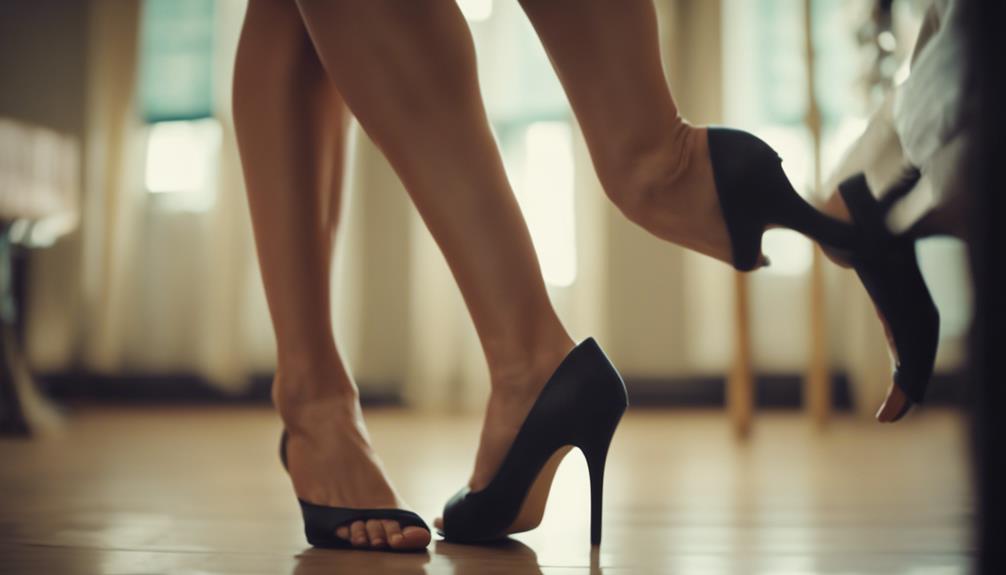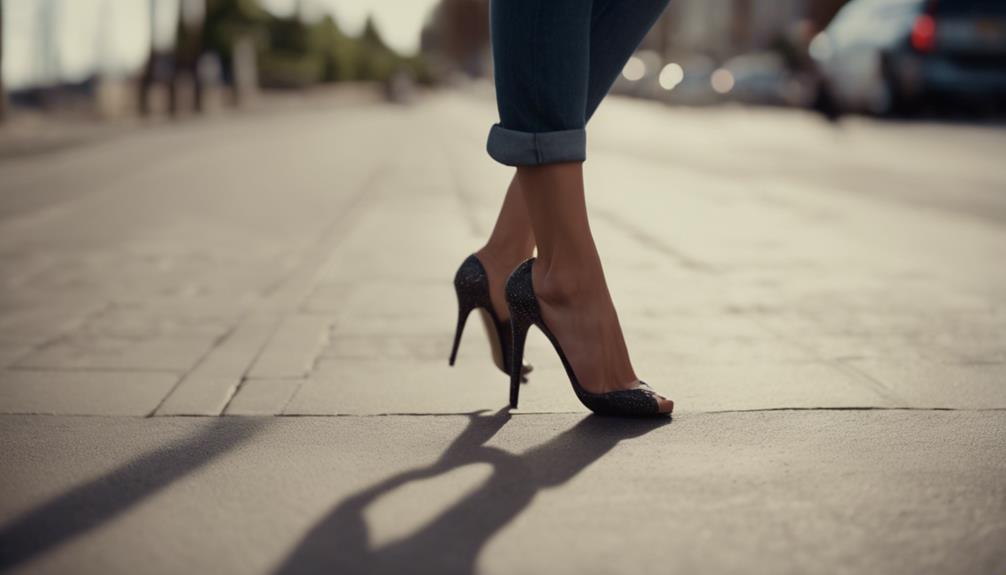Wearing heels doesn’t have to mean pain! Start with lower heels for better balance and then work your way up confidently. Focus on the construction of the shoe to understand how it impacts comfort and support. When walking, land on your heel first and keep your posture in check. Don’t forget foot care – moisturize, use insoles, and soak your feet for relief. Style wise, opt for thicker heels or wedges for more comfort. More tips and tricks await to make wearing heels a breeze!
Choosing the Right Heel Height

When selecting the appropriate heel height for comfortable wear, start with kitten heels or low chunky heels as they’re ideal for building tolerance and improving balance. These lower heel options provide a stable base for your feet while also helping you adjust to the feeling of being elevated off the ground. As someone who enjoys staying ahead of the fashion curve, I know that starting with these heel styles can set a strong foundation for venturing into higher heels with confidence.
Exploring different heel heights isn’t just about fashion; it’s also about understanding what works best for your body. By gradually increasing the height of your heels, perhaps incorporating wedges for added stability along the way, you can train your feet and improve your overall balance. This progression allows you to adapt to the changes in pressure distribution and stride length that come with higher heels.
Additionally, considering the pitch of the shoe is vital when deciding on the right heel height. Understanding how the shoe’s incline affects your arch support needs can make a significant difference in your comfort level. By starting with kitten heels or low chunky heels and gradually shifting to thicker heels, you can prepare your feet for stilettos while still prioritizing comfort and stability. Remember, testing the comfort of a heel height by slightly lifting yourself out of the shoe can help you gauge its suitability for extended wear.
Understanding Shoe Construction
Understanding shoe construction plays a crucial role in ensuring both style and comfort when selecting heels for long-term wear. The pitch of a shoe, which impacts arch support, can greatly affect how comfortable it is for walking in high heels. A steeper pitch provides more arch support, while a lower pitch offers flexibility. Comfort is key in determining the ideal pitch for an individual’s shoe preference, especially when considering long periods of wear. Additionally, the shank board construction of a shoe influences its flexibility and support, contributing to the overall comfort and stability while walking in high heels.
To better comprehend how shoe construction affects comfort, testing the heel height by lifting oneself an inch out of the shoe can help evaluate pressure points and potential discomfort areas. This simple test can provide valuable insights into how a particular shoe may feel when walking in high heels for extended periods.
Below is a table highlighting some key aspects of shoe construction that impact comfort and style when walking in high heels:
| Shoe Construction | Impact on Comfort | Impact on Style |
|---|---|---|
| Pitch | Arch support vs. flexibility | Elegance vs. practicality |
| Shank board | Flexibility vs. support | Durability vs. comfort |
| Heel height testing | Identifying pressure points | Assessing overall look |
Practicing Proper Walking Techniques

To walk comfortably and confidently in heels, it’s essential to practice proper walking techniques that prioritize stability and balance. Maintaining good posture while walking in heels is vital to prevent strain on your back and legs.
Here are some innovative tips to help you master the art of walking in heels with ease:
- Heel-to-Toe Technique: Focus on landing your heel first with each step to guarantee stability and balance. This technique helps distribute your weight evenly and reduces the pressure on the balls of your feet.
- Posture Perfection: Keep your back straight, shoulders back, and chin up while walking in heels. Good posture not only enhances your overall appearance but also diminishes the risk of discomfort or injury.
- Small Steps, Big Impact: Take small, controlled steps to improve your balance and confidence in higher heels. This practice also helps in developing a smoother and more natural stride.
- Height Diversity: Regularly practice walking in heels of varying heights to strengthen your feet and ankles. This will enhance your coordination and stability, making it easier to walk in any heel height effortlessly.
Incorporating Foot Care Practices
Regularly moisturizing your feet is key to preventing dryness and calluses while wearing heels. Walking in heels can put extra pressure on your feet, leading to dry and cracked skin. By keeping your feet moisturized, you not only maintain their overall health but also create a substantial barrier against friction and discomfort caused by prolonged walking in heels.
In addition to moisturizing, incorporating cushioned insoles or gel inserts into your heels can greatly improve your walking experience. These inserts provide extra support and help distribute the pressure more evenly, reducing the strain on the balls of your feet. This simple adjustment can make a significant difference in how comfortable you feel while walking in heels for extended periods.
After a long day of walking in heels, consider soaking your feet in warm water with Epsom salts. This practice can help relieve soreness and reduce any swelling that may have occurred. It’s a relaxing way to pamper your feet and promote recovery after putting them through the rigors of walking in heels.
Styling Tips for Heel Comfort
When selecting heels for best comfort, consider choosing styles with thicker heels or wedges to enhance balance and support. These types of heels distribute your weight more evenly, reducing strain on your feet and providing better stability while walking in heels. Additionally, opt for shoes with extra padding or cushioning in the insole to minimize pressure on the balls of your feet and heels, making your walking experience more comfortable.
Here are some innovative styling tips for heel comfort:
- Choose Brands That Prioritize Comfort: Look for footwear brands like Clarks or Naturalizer that incorporate comfort features into their heel designs, such as arch support and cushioned insoles.
- Adjustable Straps for Custom Fit: Consider heels with adjustable straps or laces for a customizable fit. This not only adds a stylish touch but also provides extra stability, preventing your feet from sliding forward while walking in heels.
- Proper Sizing is Key: Prioritize finding the right size and fit when selecting heels. Ill-fitting shoes can cause discomfort and pain, especially when walking in heels for extended periods.
- Experiment with Different Styles: Don’t be afraid to try different heel heights and shapes to see what works best for you. You might find that a block heel or a platform offers more comfort and support while walking in heels.
Conclusion
So, next time you’re hesitant to wear heels because of the pain, remember these tips and tricks to keep you walking tall and feeling confident all day long.
And for those who think heels are just too uncomfortable, I used to be in your shoes too. But trust me, with the right knowledge and practices, you can rock those heels with ease and style.
Don’t let the fear of pain hold you back from looking fabulous!

